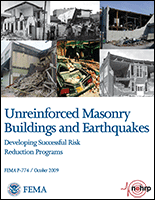Unreinforced Masonry Buildings and Earthquakes: Developing Successful Risk Reduction Programs

This publication provides guidance on reducing the risks faced by those who own, occupy, or use unreinforced masonry (URM) buildings in seismically active areas. Among structures currently in use in U.S. communities, URM buildings are typically the most vulnerable to earthquake damage and the type of construction that is most commonly singled out for voluntary and mandatory seismic risk reduction programs. The publication includes illustrations and photographs of URM buildings and describes their seismic vulnerabilities. It discusses policy and regulatory issues that often must be considered in efforts to reduce URM risks, such as retrofit costs, the economic viability of older buildings, numbers of occupants and types of use, and historic or architectural values. Rather than prescribing a rigid sequence of steps for URM risk reduction, FEMA P-774 documents a wide variety of successful approaches that have been developed across the United States.
| Size | Publication Date | ||
|---|---|---|---|
| URM Guide | 0.11M | October 1, 2009 | |
| URM Guide | 4.53M | October 1, 2009 |
